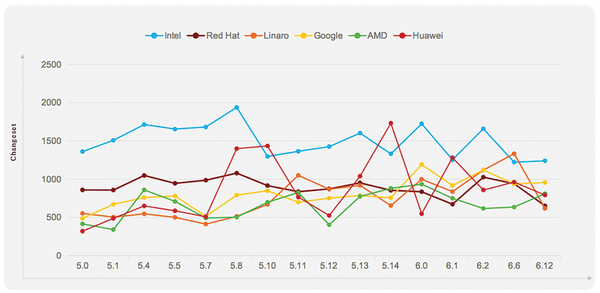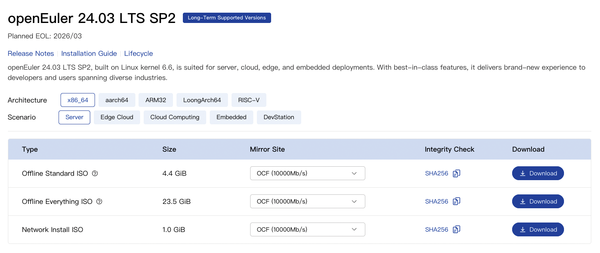Versatile Linux with eyes on the enterprise
Discovering OpenAtom openEuler

Lead Image © videst, 123RF.com
The versatile Linux system known as OpenAtom openEuler is equally at home in the server room, cloud, or edge. With a huge developer community and strong corporate support, openEuler is ready to step into the foreground as a leading enterprise Linux.
The name openEuler is coming up more frequently in Linux circles. This enterprise-ready Linux is a major presence in Asia, and the project has recently been connecting with more users in Europe and the Americas.
The openEuler project began as Euler-OS, an in-house system maintained by Chinese mega-vendor Huawei. The Huawei developers needed a system that would serve a number of different roles, from server room to cloud to edge to embedded systems, and they wanted something that would adapt easily to a new generation of alternative chip architectures. Eventually, to facilitate collaboration with industry partners, Huawei contributed the code to the community as an independent project.
The openEuler project continues with the goal of providing a system that adapts easily to different architectures and use cases. The aim is to offer a system that allows the developer to “develop once and adapt to many scenarios.”
The open source project officially launched in 2019, and since 2021 openEuler has been part of the Open-Atom Foundation (see the box entitled “OpenAtom”). If you’re wondering about the name, the distro is named for the mathematician and scientist Leonhard Euler, who gave his name to the mathematical constant e (base of the natural logarithm) and was known for contributing to several other fields of math and science. The rigor and diversity of Euler’s work is an inspiration for the openEuler team to stay flexible and keep a wide-angle view of the roles their distro can play in the ever-evolving IT space.
OpenAtom
The OpenAtom Foundation is a non-profit organization focused on developing and promoting the global open source community. The foundation sees its mission as an effort to enhance industry-wide cooperation and empower open source across a broad range of sectors. Flagship projects include openEuler and the IoT-focused OpenHarmony, but OpenAtom also supports several other important projects, including the openKylin desktop OS, the OpenTenBase database, and the OpenLoong humanoid robotics initiative. The organization provides an array of services for supported projects, including open governance, communication, outreach, legal assistance, funding, and technical support.
Introducing openEuler
The openEuler project has a very large base of contributors, users, and sponsors. The project’s close collaboration with a wide range of vendors underscores the emphasis on versatility and portability. The openEuler community includes hardware companies, chip manufactures, OS vendors, service providers, ISVs, and research institutions. Some companies and organizations maintain their own Linux distros based on openEuler, which means that openEuler serves as a kind of meta-distro (similar to Debian) for many in the global Linux space (see Table 1).
Table 1: Some of the community-certified distributions based on openEuler.
| Partner |
System |
| xFusion Digital Technologies |
FusionOS |
| UnionTech Software |
UOS |
| SUSE |
SUSE Euler Linux |
| H3C Technology |
H3Linux |
| Beijing Linx Software |
Linxos |
| TurboLinux Inc. |
TurboLinux Enterprise Server |
| Kylinsoft |
Galaxy Kylin Advanced Server |
| CSG Digital Power |
Pegasus Server |
| iSOFT |
iSOFT Server OS |
The openEuler project sees itself as a full-featured alternative to Red Hat, Suse, Ubuntu, and other enterprise distros. That might sound surprising to those in the West who are less familiar with the project and its history, but a large global development community and close ties with the hardware industry put open-Euler in a unique position for addressing many of the use-case challenges surrounding industrial Linux.
According to the openEuler project, more than 2,000 companies and institutions have joined the community, and more than 20,000 contributors have participated. Contributors include major international companies such as Intel, ARM, and AMD, as well as other organizations, such as the cloud-native Nest-OS project and the Institute for Software Chinese Academy of Sciences (ISCAS). Huawei, an openEuler strategic partner, has ranked as a top contributor in several recent Linux kernel releases (Figure 1). The breadth and depth of the openEuler project is quite impressive. According to Xiong Wei, Chairperson of the openEuler committee, more than 550 new projects have been incubated within the openEuler community over the past six years. The developers believe their investment in AI, edge, embedded, cloud, and conventional enterprise settings puts them in a strong position to adapt to future digital and intelligent infrastructure (Figure 2). According to project leaders, openEuler’s open collaboration, and its broad base of contributors, are its greatest strength.
 Figure 1: openEuler strategic partner Huawei is actively involved in Linux kernel development and frequently ranks near the top in code contributions.
Figure 1: openEuler strategic partner Huawei is actively involved in Linux kernel development and frequently ranks near the top in code contributions.
 Figure 2: The openEuler project has the ambitious goal of supporting a broad range of components and frameworks across several hardware platforms and use cases.
Figure 2: The openEuler project has the ambitious goal of supporting a broad range of components and frameworks across several hardware platforms and use cases.
Methods
openEuler puts out a new release every six months, and every two years they release a new Long-Term Support (LTS) edition. The LTS editions receive two years of comprehensive maintenance and support, and extended support is available for an additional two years. The emphasis of the LTS versions is on stability. The regular releases (dubbed “innovation releases”) offer a chance for developers and users to try out the latest technologies.
The openEuler download page offers an indication of the project’s versatility and scope (Figure 3). Choose an architecture (x86, aarch64, ARM32, LoongArch64, RISC-V) and choose a usage scenario (Server, Edge, Cloud, Embedded, or DevStation). Your selection will lead to other choices for hardware, image size, and other factors.
openEuler doesn’t just accommodate this broad range of use cases – the community is actively engaged in developing and integrating tools for the server room, cloud, edge, and embedded space. The following sections highlight some of the advanced technologies built into openEuler.
AI
With its deep connections to the hardware industry and broad support within the developer community, openEuler is well positioned to serve as a platform for AI modeling and development. The openEuler project has made AI a priority and offers what they call “full stack” AI support.
openEuler provides ready-made container images for the pytorch, tensorflow, and MindSpore AI frameworks. Other openEuler images offer support for the CUDA and CANN development platforms. You will also find images for installing Large Language Model (LLM) applications and toolchains, including Baichuan, ChatGLM, and iFLYTEK.
openEuler’s containerized approach provides a flexible and extensible ecosystem for optimizing AI development and workloads.
openEuler also comes with the sysHAX LLM heterogeneous acceleration runtime, which enhances performance for transformer models such as deepSeek, Qwen, Baichuan, and Llama. SysHAX assigns inference tasks to CPUs to make optimum use of CPU resources in AI systems.
In addition to its ecosystem of AI frameworks and modeling tools, open-Euler also offers an intelligent Q&A platform for streamlining code generation, troubleshooting, and Q&A. openEuler Intelligence uses multi-channel Retrieval-Augmented Generation (RAG) to bring AI techniques to AI development, giving developers greater control while improving efficiency. openEuler’s AI development framework can help with:
- Data preprocessing and labeling – quickly generates Q&A data for AI model training.
- Document quality improvement – anonymizes, deduplicates, and standardizes documents for better information security and efficiency.
- Model building – fine-tunes to tailor a model for a specific task.
You can access openEuler Intelligence via the web or a shell interface.
Further down in the stack, the open-Euler environment comes with a number of advanced components for supporting the data-intensive and compute-intensive systems that run AI applications (as described in the next section).
Buy Linux Magazine
Subscribe to our Linux Newsletters
Find Linux and Open Source Jobs
Subscribe to our ADMIN Newsletters
Support Our Work
Linux Magazine content is made possible with support from readers like you. Please consider contributing when you’ve found an article to be beneficial.

News
-
Debian Unleashes Debian Libre Live
Debian Libre Live keeps your machine free of proprietary software.
-
Valve Announces Pending Release of Steam Machine
Shout it to the heavens: Steam Machine, powered by Linux, is set to arrive in 2026.
-
Happy Birthday, ADMIN Magazine!
ADMIN is celebrating its 15th anniversary with issue #90.
-
Another Linux Malware Discovered
Russian hackers use Hyper-V to hide malware within Linux virtual machines.
-
TUXEDO Computers Announces a New InfinityBook
TUXEDO Computers is at it again with a new InfinityBook that will meet your professional and gaming needs.
-
SUSE Dives into the Agentic AI Pool
SUSE becomes the first open source company to adopt agentic AI with SUSE Enterprise Linux 16.
-
Linux Now Runs Most Windows Games
The latest data shows that nearly 90 percent of Windows games can be played on Linux.
-
Fedora 43 Has Finally Landed
The Fedora Linux developers have announced their latest release, Fedora 43.
-
KDE Unleashes Plasma 6.5
The Plasma 6.5 desktop environment is now available with new features, improvements, and the usual bug fixes.
-
Xubuntu Site Possibly Hacked
It appears that the Xubuntu site was hacked and briefly served up a malicious ZIP file from its download page.



